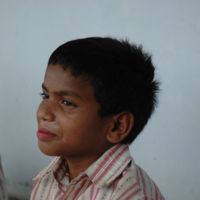
I was beaten at my school by the teacher and decided not go school again. I was so happy when I left the school but today I am facing a problem. If I had not left the school I would not be in child labor and separated from my family.
I was brought two years back by the broker, name not known to me. Before coming to the loom I was working as a daily wage labor. I was getting 10-20 rupees [$0.20-0.45] per day in the field. The poor condition of the family compelled me to work from early childhood. The broker gave 1000 rupees [$20] to my father and took me with him as a product in his carry bag. He assured my father that I would be getting proper education and small work to earn my daily bread. Being unfamiliar about the coming situation, my father sent me along with him and seeing the miserable economic condition of my family, I also did not refuse to go. When we were on the way the broker did not gave me any thing to eat, rats were jumping inside my stomach but what can be done to prevent them from jumping?
From the moment I stepped inside the loom I was made to knit the carpet. I was supposed to knit three square feet of carpet daily with my small fingers and if I failed to do so, I was beaten with sticks and iron rod. I had to work ten to 14 hours daily with a break of one hour in the morning and was not allowed to go outside. I was not even allowed to talk with my parent on a phone line. One day my father made a phone call and my owner told him: “Battis has gone somewhere.” It was very irritating to me. My friends told me that the owner does this with every child.
I never got sufficient food to eat. I always felt hungry. The quality of food was also not good—dal full of water and rice, sometimes we used to get puffed rice to eat. While doing work, whenever I felt hunger I use to think of my home where I was free to eat anything anytime. I tried to escape from the trap of the owner and I succeeded but unfortunately I was caught at a place nearly 25 kilometers from the loom. I felt bad about my condition before the rescue operation but am now feeling happy. I will open a tailoring shop and stitch clothes for my villagers. They will give me money and I will definitely not come into bondage again. I will set up an example for my friends and children of the village and prevent them from getting into the trap of bondage.
Narrative as told to Free the Slaves, July 19, 2005, at Bal Vikas Ashram, in Allahabad, Uttar Pradesh, India.

